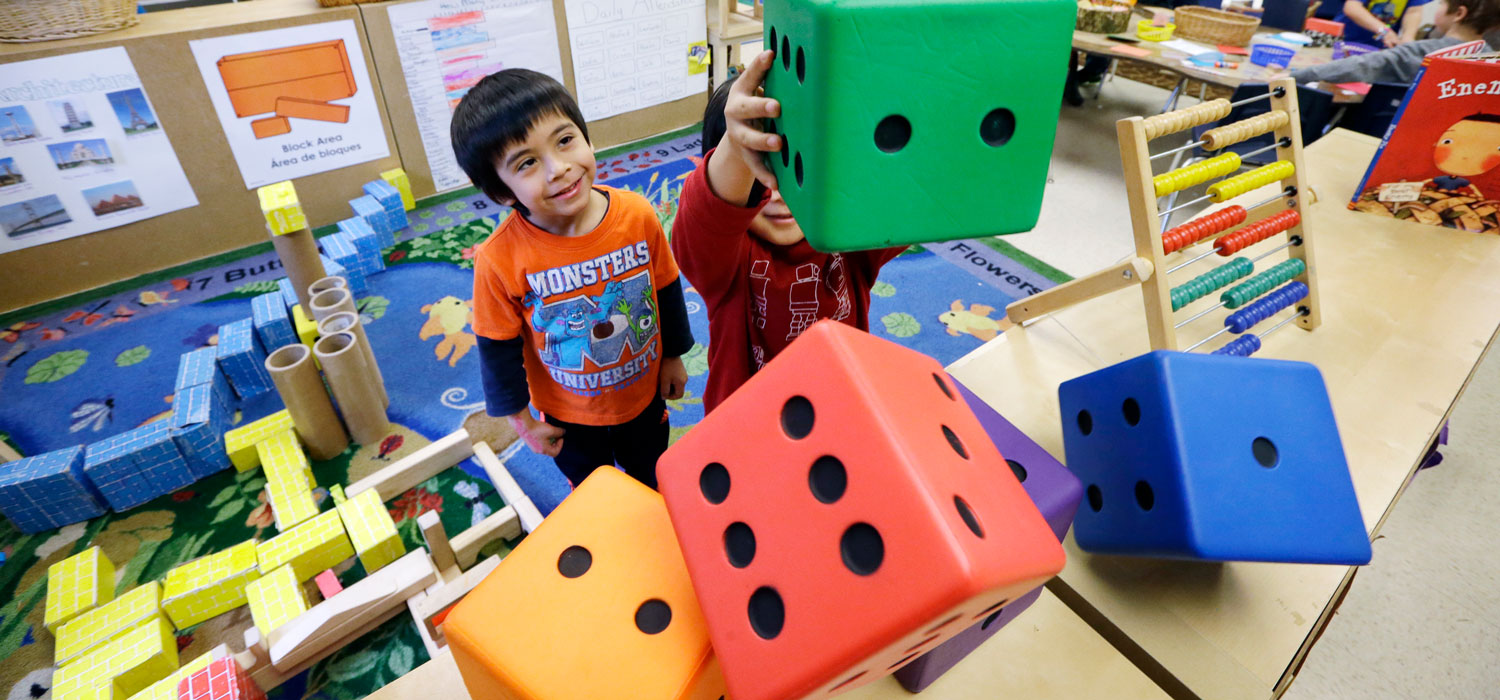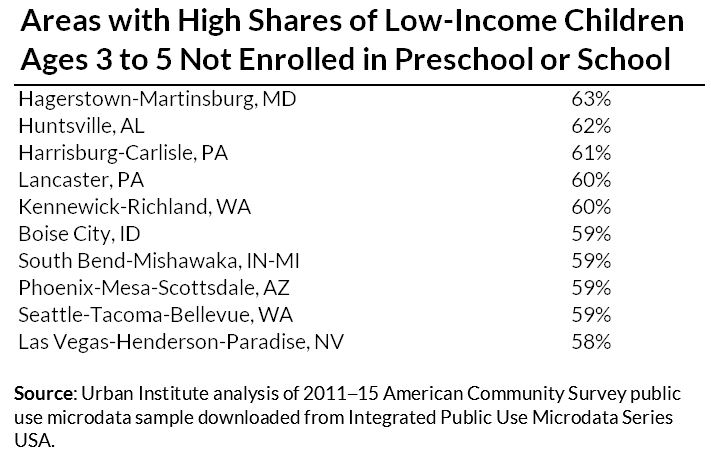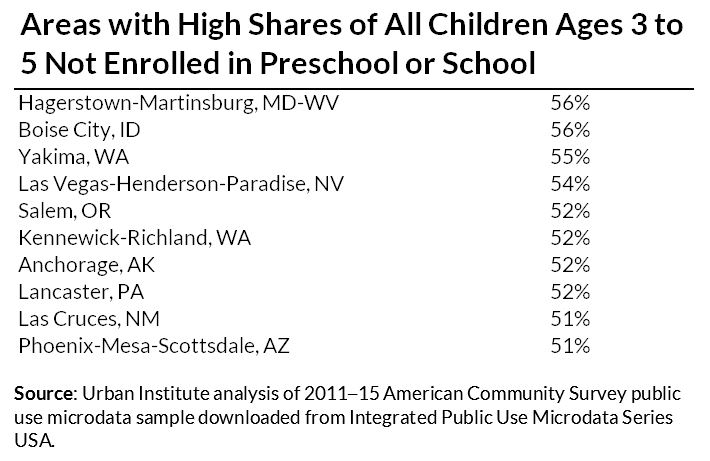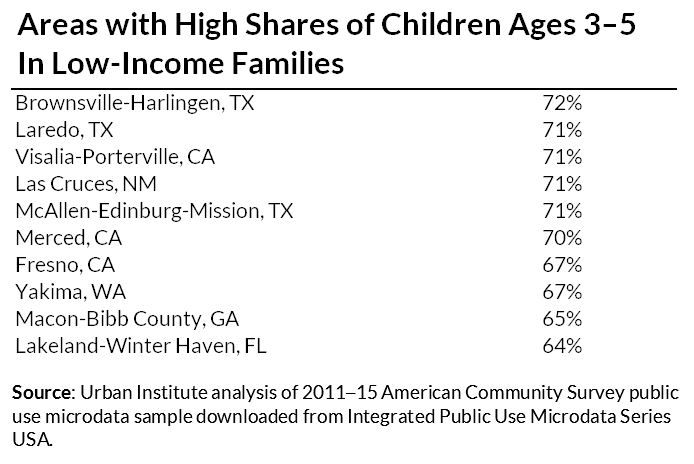
Jeff Bezos’s recent pledge to put $2 billion toward a new initiative to reduce homelessness and create and operate a network of preschools represents a significant investment in early childhood education.
Although the details remain unannounced, the preschool initiative could answer a need for many children and families. No state except California spent more than $1 billion on preschool in 2017. Many young children are not enrolled in school or preschool, despite substantial evidence showing that high-quality early childhood education has a significant positive impact on children’s lives.
Focusing on underserved areas also makes sense, as studies suggest that young children in low-income families, whom Bezos intends to serve, may stand to benefit the most from these types of programs but are less likely to be enrolled in preschool or school.
According to recent census data, 46 percent of preschool-age (3-to 5-year-old) children in low-income families nationally were not enrolled in school or preschool, compared with 40 percent of all kids in this age group.
But as the Urban Institute's preschool-age children data tool demonstrates, different areas’ share of enrolled preschool-age children and level of need varies substantially, and the characteristics of communities with low enrollment can differ as well.
This information can also help answer questions like these:
- What areas could benefit most from this new initiative?
- What areas are most “underserved” and could be target locations for these new preschools?
- What are different ways to define underserved communities?
One way to target these resources would be to serve needy groups or communities within more prosperous regions, while a second avenue would be to focus on areas that are less prosperous in general.
Where are low-income, preschool-age children most underserved?
Following this first option to identify underserved communities, one could examine areas where high shares of low-income, preschool-age children are not enrolled in preschool or school.
Limiting ourselves to metropolitan areas with 10,000 or more estimated preschool-age children because of data limitations, the communities with the highest shares of low-income, 3-to-5-year-old children not enrolled in preschool or school from 2011 to 2015 can be diverse.
This group includes the Seattle metropolitan area, Amazon’s prosperous home base, as well as Hagerstown-Martinsburg, Maryland-West Virginia, a less prosperous metropolitan area that tops the list.

More than two-thirds of preschool-age children in the Seattle area live in high-income families compared with just under half nationally, and their parents tend to have more education than those of 3-to-5-year-olds in the US overall.
But among the estimated 45,000 preschool-age children in low-income families in the Seattle area, nearly 60 percent are not enrolled in preschool or school, one of the highest rates for a metropolitan area.
Similar to the Seattle area, in the Hagerstown-Martinsburg area, more than 60 percent of 3-to 5-year-olds who live in low-income families are not enrolled in preschool or school.
But this region is less prosperous than the Seattle area, and a similar share of all preschool-age children live in higher-income families (56 percent) as in the US overall (53 percent). Young children in the Hagerstown-Martinsburg area also tend to have less educated parents and be less diverse than those in the Seattle metropolitan area.
The Hagerstown-Martinsburg area also tops the list in terms of the share of all preschool-age children that are not enrolled (60 percent) among areas with significant numbers of young children in 2011–15.
Many areas with high shares of low-income preschool-age kids not enrolled in preschool or school also have low enrollment rates among all 3-to-5-year-olds. Other metropolitan areas on both lists include Lancaster, Pennsylvania; Kennewick-Richland, Washington; Boise City, Idaho; the greater Phoenix area; and the greater Las Vegas area.

What are the communities with the highest shares of low-income preschool-age children?
Alternatively, one could identify the areas with the highest shares of preschool-age children living in low-income families. These metropolitan areas include several areas from the prior list, as well as some new additions.

Yakima, Washington, which has a high share of all preschool-age children that are not enrolled in preschool or school, also has a high share of preschool-age children in low-income families. Two-thirds of preschool-age children and nearly half the overall population in Yakima are low income.
Yakima and Kennewich-Richland, WA (which also has high shares of low-income preschool-age children and preschool-age children not enrolled in preschool or school) have higher shares of Hispanic 3-to-5-year-olds than the US, the Seattle area, and the other areas examined.
Preschool-age children in these communities are also more likely than average to be children of immigrants and have parents with limited English proficiency, meaning providing outreach and sign-up materials in appropriate languages could boost enrollment and connect young children to preschool services in these areas.
We still need to know more
Understanding the reasons behind differing enrollment rates and other varying characteristics between communities is also important as Bezos works to identify communities to target for his initiative.
To effectively target communities and support enrollment of low-income children, it will be important to understand why more preschool-age children are not enrolled in preschool or school in communities being considered for services.
Are parents choosing to “redshirt” and hold their children out of school or preschool, or do they feel constrained by the supply of slots, the cost of services, transportation challenges, the inability to sign up in their primary language, or fear of deportation for families containing undocumented members?
Bezos might also focus on finding data on smaller, rural areas, which could demonstrate an even greater need for preschools there. It will also be important to examine recent data.
Updated 2017 Census Bureau data can shed light on current trends and the status and enrollment levels of preschool-age children in both urban and rural localities. The City of Seattle approved a preschool initiative in 2014 that has shown promising results in its pilot phase, and West Virginia adopted a universal prekindergarten program in 2002 that was scheduled to fully expand by 2012–13.
Analyzing areas where expanding preschool would make the biggest impact demonstrates the varying approaches one can take when identifying and defining the need. Above all, efforts to expand preschool must rely on solid evidence so that more underserved children can access preschool’s developmental benefits.
Tune in and subscribe today.
The Urban Institute podcast, Evidence in Action, inspires changemakers to lead with evidence and act with equity. Cohosted by Urban President Sarah Rosen Wartell and Executive Vice President Kimberlyn Leary, every episode features in-depth discussions with experts and leaders on topics ranging from how to advance equity, to designing innovative solutions that achieve community impact, to what it means to practice evidence-based leadership.